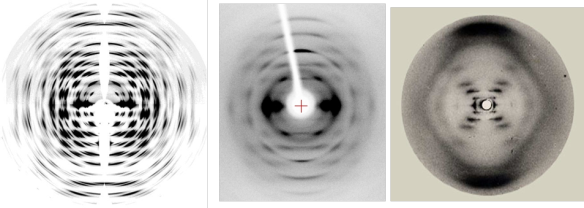Cellulose – the inner strength of plants
What is it?
 Cellulose is the most abundant natural polymer on Earth, comprised of glucose molecules joined together into long chains. It is a key component of plant materials, for example comprising 40-50% of wood. Naturally, cellulose is known to form into two crystal structures and it is the 1β form which is primarily found in plants. It is the cellulose that makes wood the strong building material that it is. The long chains of cellulose are bundled together into microfibrils and the way in which this happens can be related to the stage of growth that the plant is in (saplings have to be flexible to withstand wind but older plants tend to have stiffer stems) and also to the species of plant and the relative strengths. By studying the cellulose structure, we can understand how it provides strength and stiffness and use this to help us design better building materials; composite materials using fused synthetic and cellulose polymer chains are already being investigated. In strong wood like sitka spruce (also known as aircraft spruce) the cellulose chains are very well aligned with the direction of the trunk.
Cellulose is the most abundant natural polymer on Earth, comprised of glucose molecules joined together into long chains. It is a key component of plant materials, for example comprising 40-50% of wood. Naturally, cellulose is known to form into two crystal structures and it is the 1β form which is primarily found in plants. It is the cellulose that makes wood the strong building material that it is. The long chains of cellulose are bundled together into microfibrils and the way in which this happens can be related to the stage of growth that the plant is in (saplings have to be flexible to withstand wind but older plants tend to have stiffer stems) and also to the species of plant and the relative strengths. By studying the cellulose structure, we can understand how it provides strength and stiffness and use this to help us design better building materials; composite materials using fused synthetic and cellulose polymer chains are already being investigated. In strong wood like sitka spruce (also known as aircraft spruce) the cellulose chains are very well aligned with the direction of the trunk.

Cellulose is a polymer made up of glucose units joined together into a long chain. In strong plants such as trees, the cellulose chains all lie along the direction of growth in the crystal
That isn't the end of the importance of cellulose though. It is also being used as a source of biofuel! Cellulose grown in plants can be broken down into cellulosic ethanols by enzymes and these can be used as biofuels. Understanding how the cellulose forms into a solid is important to understand which plants will be best to use and also to help us understand how the break-down process works.
Where did the structure come from?

Fibre diffraction patterns of cellulose from tunicate (left) from which the crystal structure of cellulose 1β was determined, sitka spruce (middle) and the fibre diffraction pattern of DNA (right).
Naturally occurring cellulose doesn't form terribly good crystals so it took a long time before the crystal structure could be determined. Yoshiharu Nishiyama, Paul Langan and Henri Chanzy used a technique called fibre diffraction to determine the structure of very crystalline cellulose from tunicates and they had to use a combination of X-rays and neutrons to get to a solution [1]. This is similar to the way in which the structure of DNA was determined. Using this result, it has been possible for many groups to study the structure of cellulose in different plant materials and make some significant breakthroughs in our understanding of the function of cellulose in plants [2,3] with future implications in biofuels.
1. Y. Nishiyama, P. Langan and H. Chanzy. Crystal Structure and Hydrogen-Bonding System in Cellulose Iβ from Synchrotron X-ray and Neutron Fiber Diffraction. J. Am. Chem. Soc. 2002, 124, 9074-9082. http://dx.doi.org/10.1021/ja0257319
2. A. Fernandes, L. H. Thomas, C. M. Altaner, P. Callow, V. T. Forsyth, D. C. Apperley, C. J. Kennedy and M. C. Jarvis. Nanostructure of cellulose microfibrils in spruce wood. PNAS 2011, 108, E1195-E1203. http://dx.doi.org/10.1073/pnas.1108942108
3. M. J. Jarvis. Cellulose Biosynthesis: Counting the Chains. Plant Physiology 2013, 163, 1485-1486. http://dx.doi.org/10.1104/pp.113.231092






